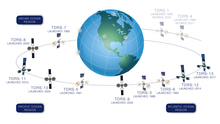

TDRS-3
Mission type
Operator
19548 [1]
Mission duration
Planned: 10 years
Elapsed: 35 years, 9 months, 17 days
Spacecraft properties
TDRS
Manufacturer
Launch mass
2,224.9 kg (4,905 lb)[2]
Dimensions
17.3 × 14.2 m (57 × 47 ft)[2]
Power
1700 watts[2]
Start of mission
Launch date
29 September 1988, 15:37:00 (1988-09-29UTC15:37) UTC
Rocket
Space Shuttle Discovery
STS-26 / IUS
Launch site
Contractor
Orbital parameters
Reference system
Regime
Longitude
151° West (1988)
171° West (1988–1990)
174° West (1990–1991)
62° West (1991–1994)
171° West (1994–1995)
85° East (1995–2009)
49° West (2009–)
29 September 1988 [3]
TDRS-3, known before launch as TDRS-C, is an American communications satellite, of first generation, which is operated by NASA as part of the Tracking and Data Relay Satellite System. It was constructed by TRW, and is based on a custom satellite bus which was used for all seven first generation TDRS satellites.[4]

The TDRS-C satellite was launched aboard Space Shuttle Discovery during the STS-26 mission in 1988; the first Shuttle flight since the Challenger disaster which had resulted in the loss of the previous TDRS satellite, TDRS-B. Discovery launched from Launch Complex 39B at the Kennedy Space Center at 15:37:00 UTC on 29 September 1988.[5] TDRS-C was deployed from Discovery around six hours after launch, and was raised to geostationary orbit by means of an Inertial Upper Stage.[5]
The two-stage solid-propellent Inertial Upper Stage made two burns. The first stage burn occurred shortly after deployment from Discovery, and placed the satellite into a geosynchronous transfer orbit. At 04:30 UTC on 30 September 1988, it reached apogee, and the second stage fired, placing TDRS-C into geosynchronous orbit. At this point it received its operational designation. Although the TDRS-2 designation had not been assigned, TDRS-C was given the designation TDRS-3 as NASA did not want to reuse the designation which had been intended for the STS-51-L payload.[6] It was briefly placed at a longitude 151° West of the Greenwich Meridian, before being moved to 171.0° West before the end of 1988, from where it provided communications services to spacecraft in Earth orbit, including Space Shuttles. In 1990, it was relocated to 174.0° West, and again in 1991 to 62.0° West. In 1994, it returned to 171.0° West.[7][8] In June 1995, it was moved to 85.0° East, from where it was used primarily for communications with spacecraft such as the Compton Gamma Ray Observatory and the Hubble Space Telescope.[7][9] In October 2009, as NASA began decommissioning TDRS-1, TDRS-3 was moved to 49.0° West,[10] where it remains in storage as of 2020.[11]


First generation
Second generation
Third generation
January
February
March
April
May
June
July
August
September
October
November
December
Launches are separated by dots ( • ), payloads by commas ( , ), multiple names for the same satellite by slashes ( / ).
Crewed flights are underlined. Launch failures are marked with the † sign. Payloads deployed from other spacecraft are (enclosed in parentheses).